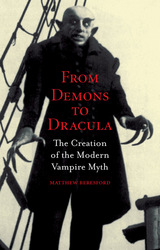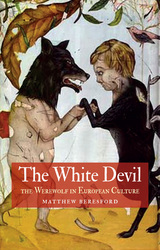2 books about Beresford, Matthew

From Demons to Dracula
The Creation of the Modern Vampire Myth
Matthew Beresford
Reaktion Books, 2008
In blood-soaked lore handed down the centuries, the vampire is a monster of endless fascination: from Bram Stoker’s Dracula to Buffy the Vampire Slayer, this seductive lover of blood haunts popular culture and inhabits our darkest imaginings. The cultural history of the vampire is a rich and varied tale that is now ably documented in From Demons to Dracula, a compelling study of the vampire myth that reveals why this creature of the undead fascinates us so.
Beresford’s chronicle roams from the mountains of Eastern Europe to the foggy streets of Victorian England to Hollywood, as he investigates the portrayal of the vampire in history, literature, and art. Opening with the original Dracula, Vlad the Impaler, and his status as a national hero in Romania, he endeavors to winnow out truths from the complex legend and folklore. From Demons to Dracula tracks the evolution of the vampire as an icon and supernatural creature, drawing on classical Greek and Roman myths, witch trials and medieval plagues, Gothic literature, and even contemporary works such as Anne Rice’s Interview with a Vampire and Elizabeth Kostova’s The Historian. Beresford also looks at the widespread impact of screen vampires from television shows, classic movies starring Bela Lugosi and Christopher Lee, and more recent films such as Underworld and Blade. Whether as a demon of the underworld or a light-fearing hunter of humans, the vampire has endured through the centuries, the book reveals, as powerfully symbolic figure for human concerns with life, death, and the afterlife.
A wide-ranging and engrossing chronicle, From Demons to Dracula casts this blood-thirsty nightstalker as a remarkably complex and telling totem of our nightmares, real and imagined.
[more]

The White Devil
The Werewolf in European Culture
Matthew Beresford
Reaktion Books, 2013
From Ovid’s Lycaon to Professor Lupin, from Teen Wolf to An American Werewolf in Paris, the lycanthrope, or werewolf, comes to us frequently on the page and the silver screen. These interpretations often display lycanthropy as a curse, with the afflicted person becoming an uncontrollable, feral beast during every full moon. But this is just one version of the werewolf—its origins can be traced back thousands of years to early prehistory, and everything from Iron Age bog bodies and Roman gods to people such as Joan of Arc, Adolf Hitler, and Sigmund Freud feature in its story. Exploring the role of this odd assortment of ideas and people in the myth, The White Devil tracks the development of the werewolf from its birth to the present day, seeking to understand why the wolf curse continues to hold a firm grip on the modern imagination.
Combining early death and burial rites, mythology, folklore, archaeological evidence, and local superstitions, Matthew Beresford explains that the werewolf has long been present in the beliefs and mythology of the many cultures of Europe. He examines prehistoric wolf cults, the use of the wolf as a symbol of ancient Rome, medieval werewolf executions, and the eradication of wolves by authorities in England during the Anglo-Saxon period. He also surveys werewolf trials, medical explanations, and alleged sightings, as well as the instances in which lycanthropes appear in literature and film. With sixty illustrations of these often terrifying—but sometimes noble—beasts, The White Deviloffers a new understanding of the survival of the werewolf in European culture.
[more]
READERS
Browse our collection.
PUBLISHERS
See BiblioVault's publisher services.
STUDENT SERVICES
Files for college accessibility offices.
UChicago Accessibility Resources
home | accessibility | search | about | contact us
BiblioVault ® 2001 - 2024
The University of Chicago Press









